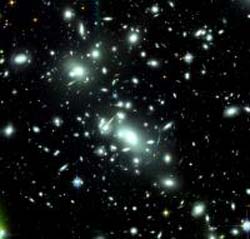’Cosmic telescopes’ may have found infant galaxies

Figure 1. (Abell 2218) The figure shows a three color image of the massive cluster of galaxies Abell 2218 taken with the Advanced Camera for Surveys in the Hubble Space Telescope. The distance to the cluster is approximately 2.5 billion light years. The blue arcs are star-forming galaxies that are behind the cluster approximately half way across the Universe. This is a beautiful example of a "cosmic telescope". Credit: H. Ford (JHU), W. Zheng (JHU), L. Infante (PUC), V. Motta(PUC, JHU), M. Postman (STScI), G. Illingworth (UCSC), M. Jee (JHU), R. White (STScI), N. Benitez (IAA), T. Broadhurst (Tel-Aviv Univ.), and NASA
Using massive clusters of galaxies as “cosmic telescopes,” a research team led by a Johns Hopkins University astronomer has found what may be infant galaxies born in the first billion years after the beginning of the universe.
If these findings are confirmed, the extra magnification provided by these gargantuan natural telescopes will have given astronomers their best-ever view of galaxies as they formed in the early universe, more than 12 billion years ago, said Holland Ford, a professor in the Henry A. Rowland Department of Physics and Astronomy at the university’s Krieger School of Arts and Sciences. Ford is the head of the Hubble Space Telescope’s Advanced Camera for Surveys Science Team, which also includes researchers from the Space Telescope Science Institute, PUC in Chile, and other universities around the world.
Ford announced the team’s results this morning at the American Astronomical Society meeting in Calgary, Alberta, Canada. The team’s spectroscopic observations were made possible, he said, by gravitational lensing, the bending of light caused by gravity’s warping of space in the presence of such massive objects as clusters of galaxies.
“One of Einstein’s most startling predictions was that a gravitation field can be thought of as a distortion of space and time,” Ford said. “Gravitational lensing by massive clusters of galaxies that have about 1 million billion times more mass than the sun provide one of the most striking confirmations of Einstein’s prediction.”
Our view of distant galaxies behind a cluster can be magnified by amounts that vary from barely detectable to as many as 50 or 100 times normal size, depending on the location of the galaxy and the distribution of mass within the cluster, Ford said. The clusters are, in effect, giant cosmic telescopes that allow astronomers to find and study distant galaxies that otherwise would be too faint to study.
“Astronomers want to know when the first galaxies formed, how large and how bright galaxies are at birth, and how galaxies grow into large mature galaxies like our home Milky Way galaxy,” Ford said. “Our team is searching for infant galaxies that are less than a billion years old by comparing images of strongly lensing clusters taken by the Hubble Space Telescope with images of the same clusters taken by the Magellan, the Very Large Telescopes (VLT), and Gemini telescopes. The infant galaxies are so far away their light is almost or entirely redshifted to wavelengths that cannot be detected with Hubble’s Advanced Camera for Surveys, but can be detected with infrared detectors on the world’s largest telescopes.”
Using this technique, the ACS team has searched for infant galaxies behind 14 lensing clusters. If longer spectroscopic observations of the three brightest candidate galaxies confirm that they are indeed in the early universe, these galaxies will provide astronomers their clearest view yet of the youngest galaxies ever seen.
Today’s presentation is based on the AAS Abstract 66.03 “Bright Candidates of Galaxies at Redshift 7-8 in the ACS Cluster Fields” by Wei Zheng1, H. Ford1, L. Infante2, V. Motta1,2, M. Postman3, and the ACS Science Team. (1Johns Hopkins University, 2PUC, Chile, 3Space Telescope Science Institute.)
The ACS was developed under NASA contract NAS5-32865, and this research was supported by NASA grant NAG5-7697. These results are based on observations collected at the European Southern Observatory, Chile; the Las Campanas Magellan Telescopes in Chile; and Gemini North, a telescope operated by the Gemini Observatory/Association of Universities for Research in Astronomy.
Media Contact
More Information:
http://www.jhu.eduAll latest news from the category: Physics and Astronomy
This area deals with the fundamental laws and building blocks of nature and how they interact, the properties and the behavior of matter, and research into space and time and their structures.
innovations-report provides in-depth reports and articles on subjects such as astrophysics, laser technologies, nuclear, quantum, particle and solid-state physics, nanotechnologies, planetary research and findings (Mars, Venus) and developments related to the Hubble Telescope.
Newest articles

Properties of new materials for microchips
… can now be measured well. Reseachers of Delft University of Technology demonstrated measuring performance properties of ultrathin silicon membranes. Making ever smaller and more powerful chips requires new ultrathin…

Floating solar’s potential
… to support sustainable development by addressing climate, water, and energy goals holistically. A new study published this week in Nature Energy raises the potential for floating solar photovoltaics (FPV)…

Skyrmions move at record speeds
… a step towards the computing of the future. An international research team led by scientists from the CNRS1 has discovered that the magnetic nanobubbles2 known as skyrmions can be…





















